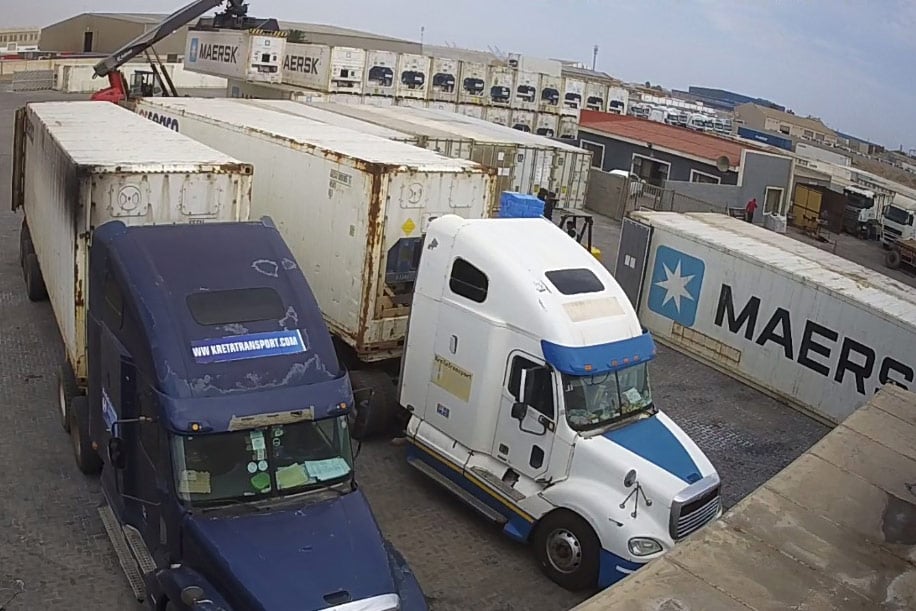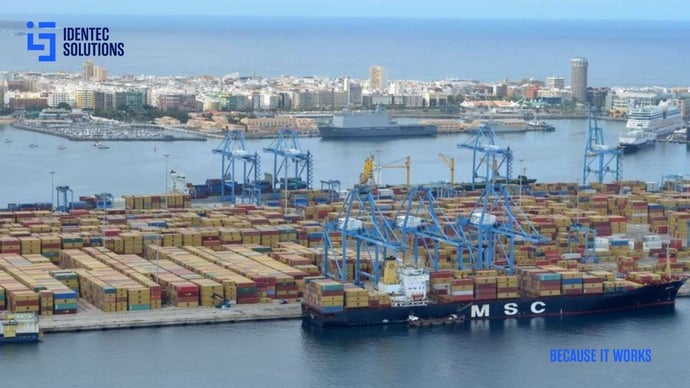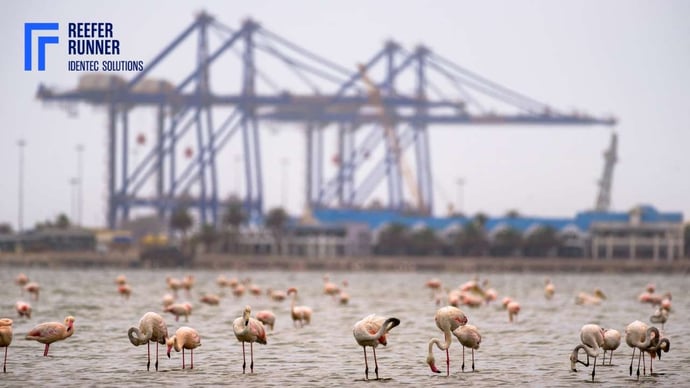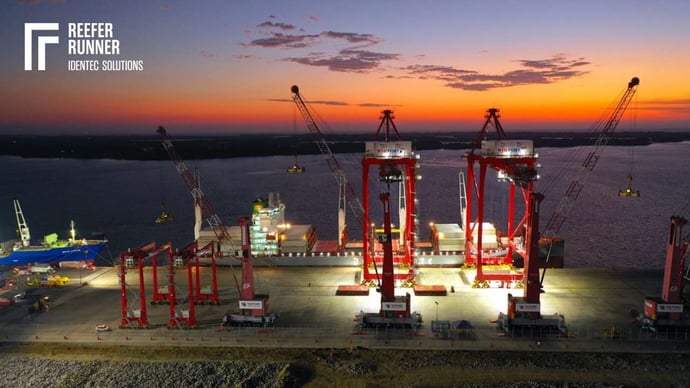Reefer tracking solution in Walvis Bay
| Written by Mark Buzinkay
Namibian Logistics specialist NamOps Logistics, located in Walvis Bay, is now equipped with the world’s most advanced Reefer monitoring and management system.

No video selected
Select a video type in the sidebar.
IDENTEC SOLUTIONS, a leading supplier of innovative wireless solutions, supplied Walvis Bay' logistics specialist NamOps Logistics with Reefer Runner, one of the world’s most advanced reefer monitoring and management solution, delivering visibility to the important south-west African port. The system was installed in the last quarter of 2021 and went live shortly after.
NamOps (Namibia Operations) Logistics is providing full service with container yard storage with pick up and transport operations and focus on optimising fully automated systems that enables their customers to track container movements in real-time. Using the latest technology enables them to provide full visibility and reliability to meet the highest quality standards in a challenging environment.
NamOps specializes in refrigerated containers with over 300 plugin points covering a range of products such as chicken, fish, meats, and seeds. In addition to refrigerated containers, NamOps handles between 120-150 dry containers per month. Their clients are located across southern Africa including, Namibia, South Africa, Botswana, Angola, Zambia.
Reefer Runner readers were installed to cover the reefer area ensuring that all refrigerated containers can be monitored and managed. Reefer Runner’s plug & play interface to NamOps current TOS, secured a seamless integration and smooth installation. The solution goes way beyond basic reefer temperature monitoring and provides true cool container management, handling the entire process while the containers are in NamOps’s care, allowing to access real-time data and reports via web-interface and, thanks to the optional modules “Energy Monitoring”, optimizing energy consumption and increasing efficiency.
“Reefer Runner was our preferred solution for our reefer cargo needs. It adds real-time visibility without the need to check reefers manually. From a safety point of view, this is important as we don't use racks. With this wireless solution we can stack up to three reefers high without using a ladder to monitor them. It even allows us to monitor reefer energy consumption without any extra hardware.” said Sergio Figueiredo, Project Manager NamOps Logistics.

Refrigerated containers play an important role in Namibia's fishing industry. 90% of the catch is being exported, partly canned, partly refrigerated. The port of Walvis Bay constitute a vital link in the export of fish and fish products from Namibia to a global market.
The Port of Walvis Bay, situated on Africa’s southwestern coast, serves as a convenient and fast transit route, connecting southern Africa, Europe, Asia and the Americas. A congestion-free port with minimum delays, the Port of Walvis Bay currently handles 7 million tonnes per annum and its total capacity equips it to handle 8 to 10 million tonnes of cargo. The new container terminal at the Port of Walvis Bay was officially inaugurated on 2 August 2019 and operationalised by 24 August 2019. This increased the throughput capacity to 750,000 TEUs (twenty-foot-equivalent units) per year. (1)
The southern African region constitutes 41% of Africa’s container throughput and is thus a critical player in the growth of the African continent. During the past two decades, the port has grown substantially, in both size and significance, from a minor national port to a key role player in the SADC region. With its recent substantial infrastructural investment in expanding the facilities at the Port of Walvis Bay, it is set to increase its relevance even more.
FAQ
How Did Walvis Bay Become a Key African Port?
Walvis Bay, located on Namibia's Atlantic coast, has long been an important maritime hub due to its deep natural harbor. The bay was first mentioned by European sailors in the late 15th century, when the Portuguese navigator Bartolomeu Dias arrived there in 1487. However, it remained largely undeveloped for centuries, serving primarily as a seasonal base for whalers and traders.
In the 19th century, Great Britain recognized Walvis Bay's strategic importance and annexed it to the Cape Colony in 1878. The goal was to secure a firm foothold on the lucrative trade routes of southern Africa. In 1884, Namibia became a German colony (as German South West Africa), but Walvis Bay remained under British control, representing a geopolitical anomaly.
After the First World War, South Africa assumed administrative control of Namibia under a League of Nations mandate, maintaining direct control over Walvis Bay. This arrangement remained in place even after Namibia's independence from South Africa in 1990. The port remained South African territory until 1994, when it was finally incorporated into Namibia.
Learn more about remote reefer monitoring and management
Glossary
The Southern African Development Community (SADC) is an intergovernmental organization established in 1980 and formalized in 1992 to promote socio-economic cooperation, political stability, and regional integration among its 16 member states, including South Africa, Angola, and Tanzania. Headquartered in Gaborone, Botswana, SADC focuses on areas like trade, infrastructure, agriculture, and security. It aims to alleviate poverty and enhance the quality of life through sustainable development and democratic principles. (2)
Throughput capacity refers to the maximum volume of containers a port, terminal, or logistics facility can handle within a specific time frame, typically measured in twenty-foot equivalent units (TEUs) per year. It depends on factors such as terminal size, equipment efficiency, labor productivity, and operational processes. High throughput capacity ensures smooth cargo flow, minimizes delays, and supports global trade. Optimizing throughput involves advanced technologies like automated cranes and digital tracking systems. (3)
References:
(1) https://www.ship-technology.com/projects/port-walvis-bays-new-container-terminal/
(2) Drewes, J.E., & van Aswegen, M. (2024): Regional Policy in the Southern African Development Community. Routledge.
(3) Rodrigue, J.P., Notteboom, T., & Pallis, A.A. (2022): Port Economics, Management and Policy. Routledge.
Note: This article was updated on the 15th of April 2025

Author
Mark Buzinkay, Head of Marketing
Mark Buzinkay holds a PhD in Virtual Anthropology, a Master in Business Administration (Telecommunications Mgmt), a Master of Science in Information Management and a Master of Arts in History, Sociology and Philosophy. Mark spent most of his professional career developing and creating business ideas - from a marketing, organisational and process point of view. He is fascinated by the digital transformation of industries, especially manufacturing and logistics. Mark writes mainly about Industry 4.0, maritime logistics, process and change management, innovations onshore and offshore, and the digital transformation in general.



